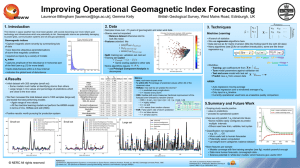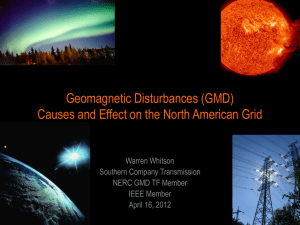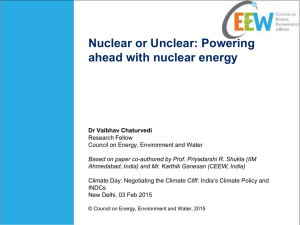Presentation (2.3 MB PPTX)
advertisement
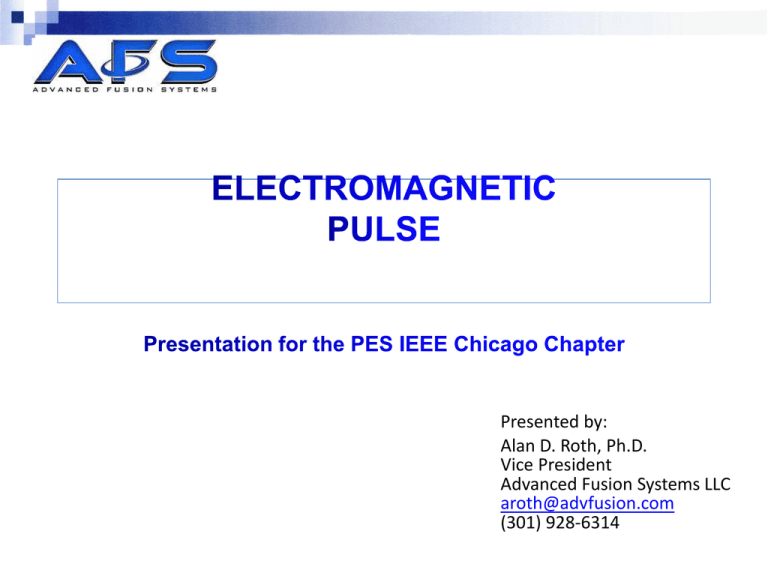
Presented by: Alan D. Roth, Ph.D. Vice President Advanced Fusion Systems LLC aroth@advfusion.com (301) 928-6314 • The Sun – almost certain • A nuclear blast – high risk • A non-nuclear strike – very high risk and near-term • An EMP generator can fit inside a van and can destroy an electrical substation from the road. • It is not difficult to get parts for it and make it. • It can be almost an order of magnitude stronger than a nuclear blast. • The van then drives to other substations unnoticed. We wouldn’t know what hit us. Example is a 3 MVA-rated Transformer. It could just as well have been a 200 MVA-rated Transformer. • The output of an EMP generator can be customized. • The wave form can be made to achieve specific damage. • Substation destruction will cascade. • The target could be a nuclear plant. • July 9, 1962 – Starfish Prime • Detonated over Johnston Island in the mid-Pacific at an altitude of 250 miles using a 1.44 megaton warhead. • The nuclear pulse reached Honolulu 898 miles from the detonation point. Burned out 300 street lights and triggered many burglar alarms. Some hotels had “Rainbow Parties” watching the aurora. • It respects line-of sight coverage. • You won’t feel the blast even if you can see it. • The pulse travels at the speed of light. • The entire continent can be victimized within the same second. • E1 will kill electronic equipment • E3 is similar to GIC • Nuclear devices can be optimized for HEMP • E1 will damage SCADA and other electronic gear including protection devices. • E2 will saturate the core of transformers and generator windings. • E3 will burn up the already saturated transformers and generators. • Nuclear cooling systems will not function. • Back-up generators will not function. • Degree of dysfunction will vary for many reasons. • The Iranians are intent on developing a nuclear HEMP capability. Their recent testing shows they are getting closer to achieving this. • The North Koreans are also specifically gearing their nuclear testing to HEMP. • Terrorist groups could also launch a HEMP attack. • If the Pakistan government falls, their nuclear weapons could be turned against us. • Russia and China have HEMP-specific nuclear weapons. Newt Gingrich: “There is a sword of Damocles over our heads. It is a threat that is real but has been all but ignored….One small nuclear weapon, delivered by an ICBM can, in fact, destroy the United States by maximizing the effect of the resultant electromagnetic pulse upon detonation.” Dr. William Graham (EMP Commission Chairman): “The current vulnerability of our critical infrastructures can both invite and reward attack if not corrected…. Several potential adversaries have the capability to attack the United States with a highaltitude nuclear weapon-generated electromagnetic pulse, and others appear to be pursuing efforts to obtain that capability.” • Solar flares often accompany coronal mass ejections. • They are sometimes launched in our direction and cause geomagnetic storms also known as “severe space weather”. • The sun surface is most active when there are a lot of sun spots but coronal mass ejections can come at us at almost any time. • The only exceptions are deep solar minimums. • They cause damage to our electric grid resulting in widespread blackouts. • They cause damage to satellites interrupting communications and GPS services among other satellite functions. • It was August 1, 2010 when the sun was just waking up from a very deep, long-lasting solar minimum. • Drawing illustrates what could not be seen. • Fortunately, none of the flares were pointed at us. • A cycle starts at a solar minimum – There are zero or close to zero sun spots at the minimum. • Sun spot numbers increase until they reach a maximum number for that cycle before decreasing back to the minimum. • Richard Carrington, an astronomer saw a bright white light as he was examining solar spots. • Not even 24 hours later, before dawn the next day, skies erupted in red, green, and purple auroras so brilliant that newspapers could be read as easily as in daylight. • Stunning auroras pulsated even at near tropical latitudes over Cuba, the Bahamas, Jamaica, El Salvador, and Hawaii. • Telegraph systems worldwide went haywire. Spark discharges set telegraph paper on fire. • With the power off, aurora-induced electric currents in the wires still allowed messages to be transmitted. Not even 100 sun spots at peak that year Dramatic rise in sun spot number • The online Operations Manual of the North American Electric Reliability Corporation (NERC) cites geomagnetic storms of 1957, 1958, 1968, 1970, 1972, 1974, 1979, 1982, and 1989 as causes of major power system disturbances. Vertical red lines show timing and intensity of storms. Only occasionally do they coincide with solar maximums. • The Carrington Event of 1859 and the Geomagnetic Storm of 1921 are considered 100-year events. • A CME rated 3 times larger than the 1921 storm glanced off of our planet in 2001. The sun emits such large CMEs about 6 times per cycle. • Direction and polarity of CMEs are critical factors. • Our last major hit was in March of 1989 but it was about 500 nanoTeslas while the 1921 storm was 5,000 nT. Geomagnetic Induced Current (GIC) Electrojets are formed around the north and south magnetic poles at altitudes of about 100km and can have magnitudes of ~1 million amps, which is sufficient in intensity to cause widespread disturbances to the geomagnetic field. • As our electric grid technology improves to give us better, more efficient service, the grid becomes more vulnerable to geomagnetic storms. • As we become more reliant on Internet and digital services, we become more vulnerable to the effects of blackouts and nuclear electro-magnetic pulse. The GIC frequencies are very low They range from 0.3 Hz to as low as 0.00001 Hz. The pulse couples best with long transmission lines. • 345kV – 45,626 miles • 500kV – 23,812 miles • 765kV – 2,064 miles1 Modeling efforts that translate the GIC environment into specific impacts to the operation of the electric power grid has required the following steps: • Modeling in detail the geographically wide-spread disturbances to the geomagnetic field. • Modeling the electromagnetic coupling that produces a geo-electric field across the surface of the Earth. • Modeling the interaction between the geo-electric field and the complex power grid topology to calculate the flow of GIC throughout the exposed power grid infrastructure. • Modeling of the operational impacts in the U.S. power grid. These modeling efforts have been highly successful! Areas of Probable Power System Collapse Impacted Regions involve population of >130 Million • Not given enough attention in GIC event consideration. • Weaknesses lie in two areas: 1. Generator rotor electrical heating due to the coupling of various harmonic currents that act as negative sequence flows in the electrical windings of generators. 2. Events that excite vibrations in the turbines at their natural frequencies can readily lead to mechanical damage to these high-speed, high-pressure blades. • Permanent and widespread damage to large MVA generators in the U.S. would likely cause especially long-term debilitating damage to the power grid. • Coronal mass ejection was launched on March 9, 1989. It reached earth 3 ½ days later. • It was manifested by a ground induced current (GIC) that coupled with transmission lines. • The greatest impact was the outage of the Quebec Province electric grid for 9 hours. • One large transformer was destroyed (cooked) at the Salem nuclear plant in New Jersey. Part of the cooked transformer Within 2 years after the March ’89 exposure, 11 nuclear plants noted failures of their large transformers, in addition to the Salem failure. The latter estimated to be largest storm of 20th Century – 10x stronger than ‘89 - extended further south The Hydro Quebec collapse during the ‘89 storm reached an intensity of ~480 nT/min. Large numbers of power system impacts in the United States were also observed for intensities that ranged from 300 to 600 nT/min during this storm. The 1921 storm has been estimated to have Peaked at 5000 nT/min The size scale of flares used by the NOAA Space Environment Center is a classification of M and X based on logarithmic decade change in the X-ray energy observed. There are several flares that have exceeded even the X category by another factor of 10, and are classified as X+. The March 13, 1989 superstorm was only in the mid range of the X class. The last X class CME was March 10, 2011. The polarity was not matched to our geomagnetic field. The large X22+ flare event of April 2, 2001, while ~30 times larger than the March 89 flare, only provided a small glancing blow upon arrival at the Earth.1 The perfect wave could be 3 times the 1921 event aimed right at us with reverse polarity. Major infrastructure systems such as the electric grid, pipelines, refineries and other chemical processing depending on SCADA will not just shut down. They may malfunction with deadly results. Includes programmable logic controllers (PLCs) example in photo We can recover from a moderate or indirect hit. But we may need to get through some weeks or some months. Those who prepare will be the most likely to regain operations. 1. 2. 3. 4. Series and Biparallel Capacitors Electron tubes Faraday Cage Back-up/replacement transformers • These are located in the transformer along the line to ground. • They have not been tested against real GIC pulses. • They may handle one pulse but driven to failure (they can explode) so they may be absent for subsequent pulses that are very likely. • They may work and they are not expensive. • Arc resistant • Need almost no cooling • Very rugged • Can handle multiple pulses without pause • Provide high level of confidence • Only viable option to counter HEMP and NNEMP • Metal shield keeps most electrical pulses out. • Must be totally enclosed with no outside wiring. Therefore, out of service. • Not an absolute solution. • Very expensive. • Difficult to order, purchase, transport, install • Many may be needed so demand will far outstrip supply • An experimental forecasting system for the North American power grid. • The crucial moment comes about 30 minutes before impact when the CME sweeps past ACE, a spacecraft stationed 1.5 million km upstream from Earth. • Solar Shield can issue an alert to utilities with detailed information about the approaching GIC. • The project needs more power companies to join the research effort. • Educate your upper echelon about this and the need for priority attention. Then educate others. • Determine what is needed to manage a week or more and then a month or more without electricity. This is not easy. • Plan what to do when satellite malfunction causes a loss of communications or GPS service. • Water, food, medical supplies, and other basics can be stored. Plan for this and start storing. • Steuben Foods in Elma, NY provides an example. www.steubenfoods.com • Put in place back-up generators where needed and adequate fuel for them. • Utilities need to communicate with major customers to see what their plans are. Work with them. • Investigate preparations at all of your locations and along your supply chains. • Plan strong protection for storage depots. • Work with InfraGuard, DHS Fusion Centers, local gov’t. • Support legislative efforts • • • • • • • Non-nuclear EMP High altitude EMP Solar storms Geomagnetic Induced Current Potential system failures Protective measures Tasks needed now • www.empcoalition.org • www.empcommission.org • www.empactamerica.org • http://www.nap.edu/catalog.php?record_id=12507 (Severe Space Weather Events--Understanding Societal and Economic Impacts) • www.survive-EMP.com
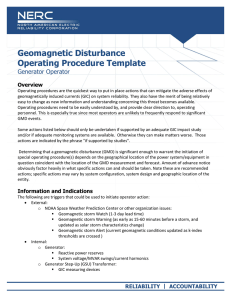
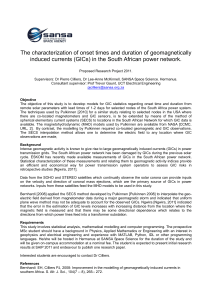

![The Politics of Protest [week 3]](http://s2.studylib.net/store/data/005229111_1-9491ac8e8d24cc184a2c9020ba192c97-300x300.png)


